
Manufacturer's Specifications:
Frequency Response: 2 Hz to 22 kHz, ±0.5 dB.
Dynamic Range: Record, 90 dB; playback, 96 dB.
S/N: 92 dB.
THD: 0.005% or less at 1 kHz, 0 dB.
Wow & Flutter: Below measurable limits.
Analog Input Level and Impedance: 316 mV for 0 dB, 47 kilohms.
Digital Input Level and Impedance: 0.25 V peak to peak, 75 ohms.
Analog Output Level and Impedance: 2 V at 0 dB, 100 ohms.
Digital Output Level and Impedance: 0.5 V peak to peak, 75 ohms.
Headphone Output Level and Impedance: 30 mW at 32 ohms.
Tape Speed: 8.15 mm/S.
Search Speed: 200 times normal speed, maximum.
Fast Winding Time: 50 S for 120-minute tape.
Power Requirements: 120 V. 60 Hz. (Sample tested was 100-V. 60-Hz version.)
Dimensions: 18.1 in. W x 4.6 in. H x 15 in. D (46 cm x 11.7 cm x 38.1 cm).
Weight: 24.3 lbs. (10.9 kg).
Price: Not available.
Company Address: Akai Div. of Mitsubishi, 225 Old New Brunswick Rd.. Piscataway. N.J. 08854.
Although DAT recorders are available in Japan and many European countries, as of this moment you still can't buy them from authorized dealers in the United States. Nevertheless, this situation is not likely to continue indefinitely, despite the attempts of certain record companies to stop audio technology from progressing along logical lines. That being the case, I was happy to be able to look at another DAT entry, Akai's Model AD-93. Its designers have taken advantage of just about every user convenience feature of the R-DAT Standard, which was created by 84 companies more than three years ago. Beyond convenience features, Akai has concentrated its engineering effort in creating an excellent, reliable tape transport system as well as digital and analog circuit topology that takes full advantage of R-DAT's recording and playback potential.
The AD-93 offers complete automatic subcode recording functions. When you make a DAT recording, start ID, pro gram number and absolute time are automatically recorded as well. If you want to change the start ID codes, you can manually erase or record start ID points even after a recording has been made without affecting the audio program in any way. Renumbering of programs is also possible. Once a tape has the recording numbers encoded, you can program up to 60 selections for play from among a maximum of 39 numbered selections on the tape. Direct selection of pro gram numbers is accomplished by using the number keys on the supplied remote control. Skipping one or more selections, either forward or backward on a tape, is possible by using appropriate keys on the front panel or on the remote.
Fast cue and review, at 16 times normal play speed is available, as are the now familiar repeat play modes common to most CD players (and DAT recorders). A particularly attractive feature is "End Search," a function that quickly finds the end of all recorded material on a tape that's still partially blank. With a maximum recording time of two hours, I find that I rarely fill up a tape in one recording session. It's nice to be able to find the exact spot to begin recording the next time I want to add material to that tape.
Using an external timer, it is possible to set the AD-93 so that it will record a program in your absence or begin playback at a specified time. As if the microprocessors in a mechanism such as the AD-93 didn't have enough to do, this deck even displays nine different error messages if it encounters such problems as moisture condensation, bro ken tape, overly thin tape, transport motor problems, etc.
Less obvious but equally important are some of the AD-93's structural features. The capstan motor is a high-torque, direct-drive type, as is the head drum motor. Three addition al d.c. motors are employed for reel drive, tape loading, and cassette tray drives. The tape head mounted in the spinning head drum is a spatter Sendust type, combining the magnetic properties of Sendust with the wear-resistant qualities of ferrite. The head drum itself uses a new silicon-enhanced aluminum alloy for reduced tape and head wear. The chassis features a thick upper panel (1.6 mm) and triple-layer construction of the side panels, and it is supported on large pedestal-type feet for reduced vibration.
Six power supplies are used in the AD-93, with the analog supplies completely separated from the supplies powering the digital circuitry. Separate digital and analog signal-handling circuit boards are used. Audio amplifier circuitry is divided into four separate sections: Recording, playback, left, and right.
Unlike some of the very first DAT recorders I tested, this one offers two-times oversampling digital filtering and independent A/D converters on the recording side, together with four-times oversampling, digital filtering, and independent left- and right-charnel D/A converters for playback.
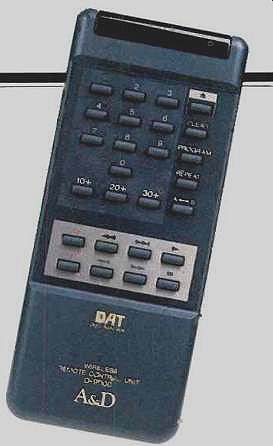
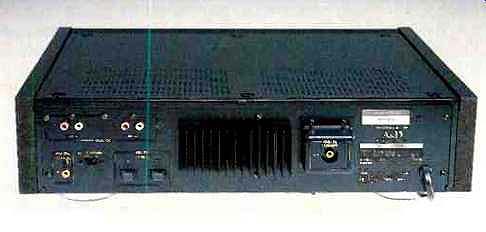
Control Layout
The front-panel layout resembles that of some of the other DAT machines I have evaluated. A power switch, head phone jack, and headphone level control are at the extreme left. Along the top half of the panel are the smooth-gliding cassette drawer, a large fluorescent display area, and a pair of concentrically mounted record level controls.
The counter display shows either elapsed time, absolute time, or time of a given numbered program. If playback of a tape is initiated from its beginning, the elapsed and absolute display times will be the same. However, if you insert a tape that's partly wound onto the take-up reel in its cassette housing, the counter will read elapsed time starting from the new play point, but absolute time from the beginning of the tape. Program number, repeat play, tape-travel mode, and start ID indications are provided in the display area, as is a digital peak-reading recording level meter calibrated from 0 down to -42 dB. The metering system has a peak hold function that temporarily retains level indications above -21 dB. Overrecording--a situation to be scrupulously avoided with any digital recording system-is shown by a bright red indicator at the right end of the peak level meter Other indicators in the display area show that the deck is in record mode, when "digital direct" mode has been selected, and the record or playback sampling frequency.
Remaining controls are arranged in two rows along the lower half of the front panel. A "Tape View" button in the upper row, when depressed, illuminates the cassette area during playback or recording so that you can see how much tape is left. This is a handy feature, but in my view it does not replace the accurate tape remaining indicators that some other DAT machines have. Other buttons along this upper row include "Counter Mode," "Counter Reset," forward and reverse program skip controls, and fast forward and rewind controls that also serve as cue and review buttons when the recorder is in play mode.
Controls and switches along the bottom row include "Timer Start" (used in combination with an external timer), "End Search," cassette tray "Open/Close," "Repeat," and "A-B" repeat. There are four subcode handling buttons: "Erase," to erase unwanted start ID subcodes; "Auto," to select automatic or manual subcode recording; "Write," to record the start ID data at any point on a tape, and "Renumber," to change program numbers in order (from 1 upward). Other controls in the bottom row are "Audio Mute" (for creating blank sections on a tape), "Rec Pause" (to obtain record mode prior to moving the tape so that you can set levels), "Play," and "Stop." A "Loading Off" button moves the tape away from the head to prevent tape and head wear during pauses. The tape is automatically moved away from the head drum if no operation is performed for 10 minutes.
The rear panel is equipped with analog pairs of input and output jacks, a digital coaxial input and output jack, an optical digital input and output jack, and an "Auto Rewind" selector with which you can choose to have the tape stop or rewound automatically when the end is reached.
Measurements

Fig. 1A--Record playback frequency response at 0-dB record level of left channel
(solid curve) and right channel (dashed curve) using dub of CBS CD-1 test disc.
Fig. 1B--Record playback frequency response at 0 dB (using dub of CD-1 test disc) and at -20 dB (using Japan Audio Society test tape).
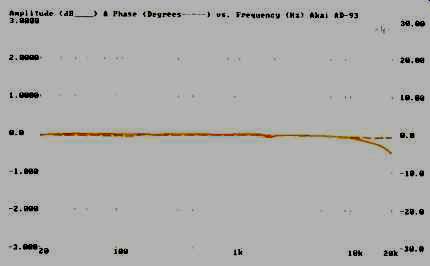
Fig. 2--Frequency response (solid curve) and interchannel phase response (dashed
curve).
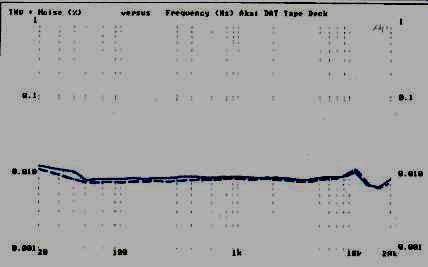
Fig. 3--THD + N vs. frequency at 0-dB recording level of left (solid curve)
and right channels.
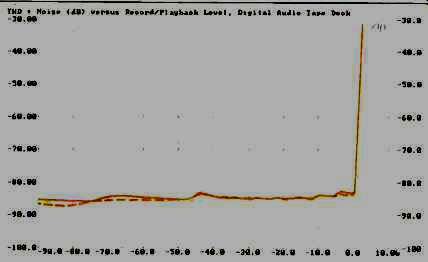
Fig. 4--THD + N vs. record playback level of left (solid curve) and right
channels.
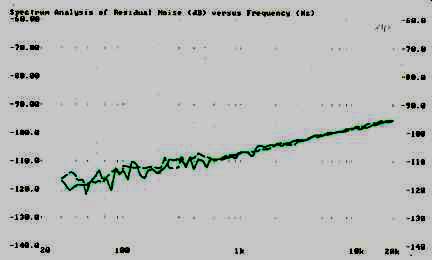
Fig. 5--Spectral analysis of residual noise, using 1/3-octave band-pass filters,
left (solid curve) and right channels.
There are very few pre-recorded test tapes available for testing DAT recorders. I have one from Sony that contains only a few test frequencies at maximum recording level on both channels, and even fewer test frequencies for testing channel separation and distortion at -60 dB. Recently, I acquired a test tape issued by the Japan Audio Society (an active group which also produced an excellent CD test disc early on in the development of CD players). Though largely devoted to musical selections for subjective testing, this tape does contain a full array of spot frequencies as well as a sweep from 20 Hz to 20 kHz, recorded at -20 dB.
The AD-93 is the first DAT recorder I've been able to test using my recently acquired computer-driven Audio Precision System One test gear. With the aid of this programmable equipment, I was able to prepare some of my own test tapes, admittedly via the digital-to-analog-to-digital recording and playback route. Since this is the way most users will record and play back anyway, I felt that it was a fairly legitimate approach. Among the test tapes I prepared is a recording of my favorite (and EIA-approved) CD test disc, the CD-1 issued by CBS Records. Of course, the DAT Standard did not permit me to prepare this test tape by digital-to-digital recording either; digital recording in DAT decks is confined to a sampling rate of 32 or 48 kHz, whereas the CD-1 (like all CDs) has a sampling rate of 44.1 kHz.
Figure 1A is a graph of frequency response using the dub of the CD-1's frequency sweep. The level was adjusted for maximum (0 dB) as indicated on the AD-93's peak-reading meter. Response of both channels was plotted simultaneously and was identical over the range of frequencies measured. Response was down only -0.23 dB at 20 kHz try accomplishing that with any analog cassette deck, using any grade of tape, at 0-dB recording level! Here's one of the great advantages of Digital Audio Tape-there's no such thing as tape saturation at high frequencies! When you are recording zeroes and ones at a fixed level on tape, the tape doesn't really care whether their patterns alternate back and forth 20 times a second or 20,000 times a second. Furthermore, when you use a DAT machine, what you put in during recording is what you get out during playback.
To further illustrate this point, I compared my homemade swept frequency tape's response with the -20 dB pre-recorded frequency sweep supplied on the Japan Audio Society's test tape. The results are shown in Fig. 1B. To show both curves, I changed the vertical calibration of this graph (easily accomplished with the Audio Precision system), but it is clear that the curves are about as identical as any two frequency response curves can be.
In Fig. 2 yet another vertical scale was used, this time extending only ±3 dB about the 0-dB axis. In this graph, frequency response is shown once more (solid curve), but superimposed on it is the interchannel phase response of the system through the entire record/play process. Phase error at 20 kHz (indicated by the dashed curve and the right-hand vertical scale) was a mere - 0.89°! Compare this with the azimuth of any accurately aligned cassette deck, and you'll see why DAT recorders are so superior in this regard as well.
Figure 3 shows how THD + N varied with frequency. The variation, in fact, was negligible. At 1 kHz, THD + N was approximately 0.008%. While this appears at first glance to be slightly worse than Akai's specification, I should point out that I measure THD plus noise, whereas Akai quotes only THD. The 87-dB A-weighted signal-to-noise ratio that I measured for this recorder (using the record mute feature of the deck to record a "quiet" section of tape) corresponds to a level of 0.005% all by itself, so the combined reading of 0.008% for THD + N is really not out of line.
Figure 4 is a plot of THD + N versus recorded level. Instead of expressing THD N as a percentage, the vertical scale is calibrated in dB below maximum recorded level. This method of presentation shows that the quantization distortion, in absolute terms of amplitude, remains virtually constant at all recording levels from-90 to 0 dB. As might be expected, however, the moment the recording level exceeds the 0-dB mark, the distortion curve rises almost vertically. At a recording level of +2.0 dB, distortion has reached more than 2.0% (- 30 dB corresponds to just over 3.16%). Learning to stay below that dangerous "0-dB" mark on a DAT recorder is going to take some practice for those who are accustomed to letting analog cassette deck meters go well above the 0-dB mark on peaks. On the other hand, backing down too much when making a DAT recording means sacrificing some of the dynamic range and signal-to-noise ratio potential of the digital recording pro cess. Using the EIA's technique for measuring dynamic range, I obtained a figure of 94 dB for the complete record/ play cycle. Using the EIAJ's method (THD at-60 dB, expressed in dB, plus 60 dB), dynamic range was only 84 dB. I believe that the EIA method is a more legitimate way of defining dynamic range and will therefore continue to use it when measuring this parameter on CD players as well as DAT recorders.
Figure 5 shows a spectral analysis of residual noise produced by the Akai AD-93. A 1/3-octave band-pass filter was used in making this analysis, and, as you might expect, noise tended to rise with frequency.
Figures 6A and 6B may appear to be identical, but they are not. Because a DAT recorder converts analog input signals to digital form, records that digital data on tape, and then, during playback, reverses the process, it has been suggested that the tape itself has little or no effect on the measured performance. If that were the case, it should be possible to test a DAT recorder without even using moving tape. One could simply apply a signal to the inputs and then monitor the output via the analog output jacks, since the input signals will have gone through the entire ND and D/A conversion via the recorder's record and playback circuitry.
Indeed, this proved to be true in nearly all of the tests I performed on the AD-93. I recorded all my tests onto tape and then played them back. However, I found that results were the same when I simply applied signals to the analog inputs and measured the signals at the analog outputs. One exception occurred when I measured separation. Figure 6A shows how separation varied as a function of frequency when I omitted the intermediate step of actually recording tones on the tape. Under these conditions, separation measured 85 dB at 1 kHz, yet when I actually recorded a sweep of frequencies on tape (for the left channel) and played the tape back, separation decreased just a bit (Fig. 6B). Now, separation at 1 kHz measured 82 dB, a difference of 3 dB. I can't tell you just what caused this slight decrease in separation. Theoretically, it should not have occurred, but it taught me a lesson: You can't always rely on theory. From now on, all DAT testing will be done through the full record/ play cycle, theories notwithstanding!
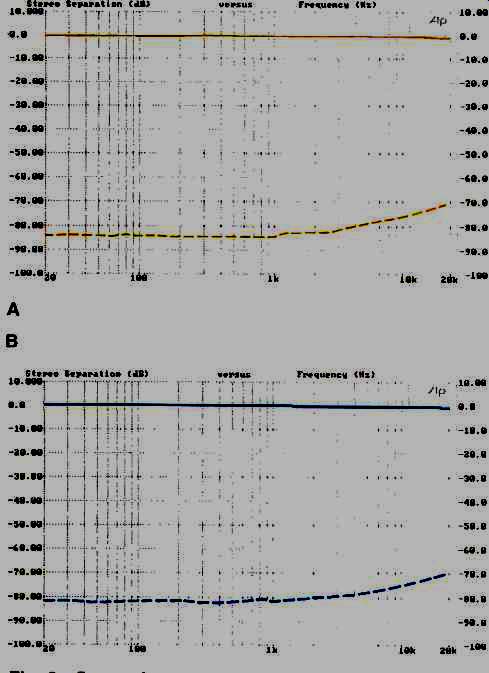
Fig. 6--Separation vs. frequency with signals passing only through the AD-93's
electronics (A) and with sweep of frequencies recorded on tape, played back,
and measured for one channel (B). See text.
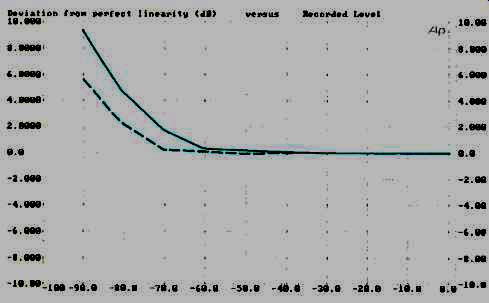
Fig. 7-Deviation from perfect linearity for left (solid curve) and right channels
using undithered signal.

Fig. 8--Same as Fig. 7 but using low-level, dithered test signal.
I decided to check the AD-93's linearity even though I realized full well that using the analog dub of the CD-1's linearity test tracks was not a very rigorous test of this important parameter. Since no digitally prerecorded tapes involving linearity testing were available, I decided that using the analog copy would be better than nothing. The results, expressed as deviation from perfect linearity, are shown in Fig. 7. I was not at all surprised to see that the deviation was greater than what I usually measure for a CD player. I'm reasonably certain that most of the deviation is due to nonlinearities in the analog circuitry (both recording and playback) of the DAT recorder rather than with the A/D and D/A conversion processes themselves.
I repeated the test, using a low-level dithered signal (again, recorded through the analog inputs onto a DAT cassette and then played back to make the measurement).
This allowed me to compare results of a dithered signal (Fig. 8) with those of an undithered signal (Fig. 7). Sure enough, while the deviation from perfect linearity at -90 dB for the undithered signal was over 9 dB for the left channel and nearly 6 dB for the right, deviation at -90 dB measured only 7 dB for the left channel and 3.3 dB for the right using the dithered test signal.
Use and Listening Tests
The few prerecorded musical DAT cassettes that I own really don't contain enough material for me to be able to judge sound quality with the level of confidence I would like-especially since I don't have copies of the same material on CDs, LPs, or analog cassette tapes. Despite this, I can say that the musical numbers on the Sony and the Japan Audio Society test tapes were reproduced by the AD-93 with the same kind of noise-free, distortion-free qualities that I have come to associate with CD sound. Indeed, even when I recorded a few favorite CD tracks onto a DAT cassette using the analog inputs, the sound quality of the playback was barely distinguishable from the original CD. In one or two cases, I did seem to lose some of the dynamic range of the CD when it was transcribed to DAT, but I attribute this to my being a bit overcautious in setting re cording levels.
I have one small criticism about the transport functions of this machine. The record/pause control enables the user to go into the record mode (without actually starting to record) when setting levels, but there is no similar function available when accessing a particular program during playback. Regardless of whether you are in play or stop mode, if you call up a given program number, the transport will rapidly zip through the tape to find the exact start of the program. Then it begins to play the program immediately, without pausing or stopping. I suppose this is really minor, but I would have liked to have had the option of reaching the desired pro gram and pausing until I hit the "Play" button or of going right into play mode when the desired program start point was reached.
In terms of its circuitry, construction and features, I regard the Akai AD-93 as a "second-generation" DAT recorder. Its designers have obviously studied the first DAT units and have tried, with some success, to improve upon them.
Perhaps our long wait for DAT in this country will have some benefit after all. By the time we can buy a DAT recorder at our local audio shop, maybe we will have reached the third generation of products. Remember that the first CD players were not all they were cracked up to be-at least compared with what's available now. Don't get me wrong! I think we, as audio enthusiasts, ought to be allowed to decide whether current DAT machines are good enough for our needs, rather than having the decision taken out of our hands by he major record companies and Congress. If you're planning a trip to Japan soon (of if you know a dealer bringing in gray-market DAT recorders directly from Japan), the Akai AD-93 is certainly one DAT recorder worth considering.
-Leonard Feldman
(Source: Audio magazine, Jun. 1988)
Sony DTC-75ES DAT Recorder (Nov. 1990)
DECIDING ON DAT: Witness of the Persecution (Mar. 1988)
Akai 4000DS Tape Deck (May 1974)
= = = =